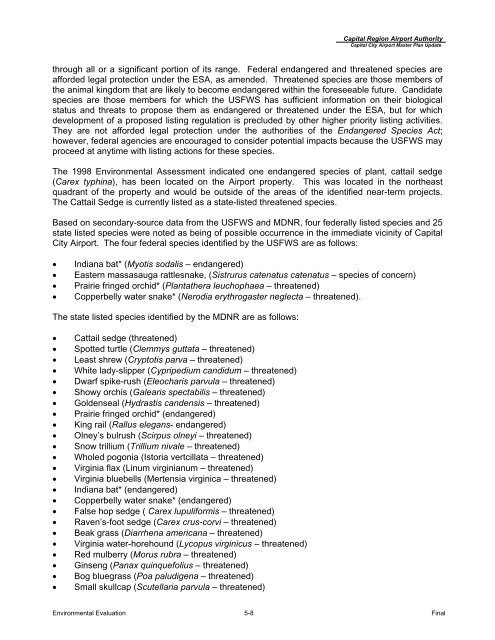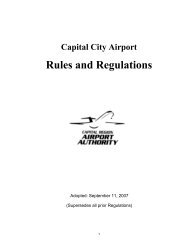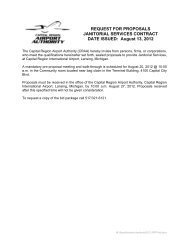Master Plan Update (pdf) - Lansing/Capital City Airport
Master Plan Update (pdf) - Lansing/Capital City Airport
Master Plan Update (pdf) - Lansing/Capital City Airport
You also want an ePaper? Increase the reach of your titles
YUMPU automatically turns print PDFs into web optimized ePapers that Google loves.
<strong>Capital</strong> Region <strong>Airport</strong> Authority<br />
<strong>Capital</strong> <strong>City</strong> <strong>Airport</strong> <strong>Master</strong> <strong>Plan</strong> <strong>Update</strong><br />
through all or a significant portion of its range. Federal endangered and threatened species are<br />
afforded legal protection under the ESA, as amended. Threatened species are those members of<br />
the animal kingdom that are likely to become endangered within the foreseeable future. Candidate<br />
species are those members for which the USFWS has sufficient information on their biological<br />
status and threats to propose them as endangered or threatened under the ESA, but for which<br />
development of a proposed listing regulation is precluded by other higher priority listing activities.<br />
They are not afforded legal protection under the authorities of the Endangered Species Act;<br />
however, federal agencies are encouraged to consider potential impacts because the USFWS may<br />
proceed at anytime with listing actions for these species.<br />
The 1998 Environmental Assessment indicated one endangered species of plant, cattail sedge<br />
(Carex typhina), has been located on the <strong>Airport</strong> property. This was located in the northeast<br />
quadrant of the property and would be outside of the areas of the identified near-term projects.<br />
The Cattail Sedge is currently listed as a state-listed threatened species.<br />
Based on secondary-source data from the USFWS and MDNR, four federally listed species and 25<br />
state listed species were noted as being of possible occurrence in the immediate vicinity of <strong>Capital</strong><br />
<strong>City</strong> <strong>Airport</strong>. The four federal species identified by the USFWS are as follows:<br />
• Indiana bat* (Myotis sodalis – endangered)<br />
• Eastern massasauga rattlesnake, (Sistrurus catenatus catenatus – species of concern)<br />
• Prairie fringed orchid* (<strong>Plan</strong>tathera leuchophaea – threatened)<br />
• Copperbelly water snake* (Nerodia erythrogaster neglecta – threatened).<br />
The state listed species identified by the MDNR are as follows:<br />
• Cattail sedge (threatened)<br />
• Spotted turtle (Clemmys guttata – threatened)<br />
• Least shrew (Cryptotis parva – threatened)<br />
• White lady-slipper (Cypripedium candidum – threatened)<br />
• Dwarf spike-rush (Eleocharis parvula – threatened)<br />
• Showy orchis (Galearis spectabilis – threatened)<br />
• Goldenseal (Hydrastis candensis – threatened)<br />
• Prairie fringed orchid* (endangered)<br />
• King rail (Rallus elegans- endangered)<br />
• Olney’s bulrush (Scirpus olneyi – threatened)<br />
• Snow trillium (Trillium nivale – threatened)<br />
• Wholed pogonia (Istoria vertcillata – threatened)<br />
• Virginia flax (Linum virginianum – threatened)<br />
• Virginia bluebells (Mertensia virginica – threatened)<br />
• Indiana bat* (endangered)<br />
• Copperbelly water snake* (endangered)<br />
• False hop sedge ( Carex lupuliformis – threatened)<br />
• Raven’s-foot sedge (Carex crus-corvi – threatened)<br />
• Beak grass (Diarrhena americana – threatened)<br />
• Virginia water-horehound (Lycopus virginicus – threatened)<br />
• Red mulberry (Morus rubra – threatened)<br />
• Ginseng (Panax quinquefolius – threatened)<br />
• Bog bluegrass (Poa paludigena – threatened)<br />
• Small skullcap (Scutellaria parvula – threatened)<br />
Environmental Evaluation 5-8 Final




